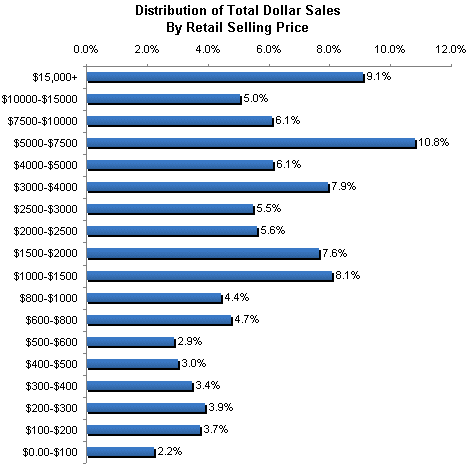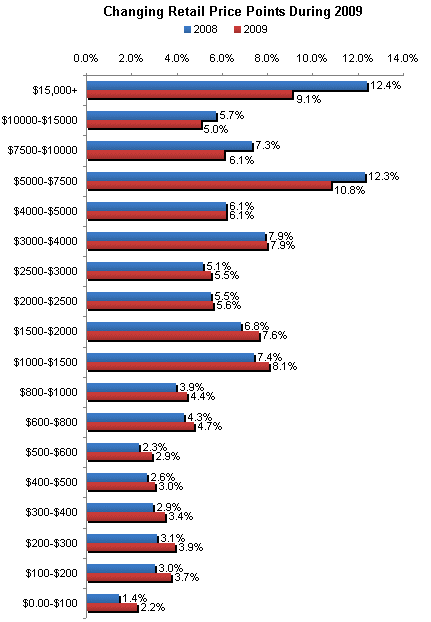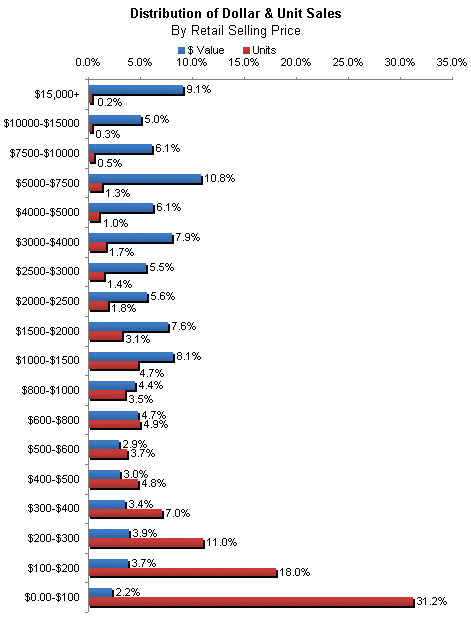IDEX Online Research: Jewelry Industry Winners vs. Losers, Information Makes the Difference
May 17, 10
You barely survived the recession. Now, remember all of those promises you made about what you would do differently if you made it through the Great Recession? Now, it’s time to make good on your promises.
“Implementing a management information system” should have been at the top of your list. Think back, you struggled to figure out what was selling. You struggled to understand which merchandise you should melt, send back or blow out at distress prices. “Ahhh,” you thought, “if I only had a good management information system on my computer, I would never have gotten into this mess.”
You were not alone back then, and you still have plenty of company today: too many jewelry merchants are still without a viable management information system.
The Recession: A Wake-Up Call
Plummeting sales and sharply lower average tickets sent panic through the U.S. jewelry industry in 2009, paralyzing many jewelers who weren’t able to react because of the lack of detailed information about merchandising, inventory management and profits.
Despite the wake-up call that the recent recession provided, far too many U.S. jewelers still don’t have a basic understanding of the tools they need to manage their business.
In today’s highly competitive world, merchants can’t run their business by scribbling numbers on the back of an envelope.
Further, in the “new normal” for the jewelry industry – less availability of memo goods, suppliers who are less willing to provide extended terms, and banks who control the cash spigot more tightly than ever – jewelers must review their business models with an eye toward increasing financial efficiencies especially related to capital utilization. Those are fancy words for “make your cash work harder than ever.”
How can jewelers make their cash work harder? IDEX Online Research has been a long-time advocate of management information systems. Good systems can help a merchant understand what’s selling, and more important, what’s not selling. Good systems can help retailers manage their inventory, their vendors and their cash flow.
Recently, Buyers International Group (BIG) released jewelry sales data for 2009 from their Balance-To-Buy (BTB) management information system. While we aren’t promoting the BTB system – there are many others available including ARMS, Edge, and others – the BTB system highlights how a good management information system should work and what it can do for jewelers.
The information that BIG sent to IDEX Online Research includes results from a sample of independent specialty jewelers with average annual sales per store of about $2.2 million and an average ticket in the $700-800 range. In comparison, the average ticket for a Kay or Zale store is about $350 or so, with sales per store of $1.0-1.5 million. The average ticket for an AGS store is close to $1,000, with sales per store of about $2.4 million. For further comparison, the per-store sales for the typical U.S. specialty independent jeweler were $1.1 million in 2008, as reported by the Jewelers of America Cost of Doing Business Survey. Thus, we conclude that the BIG store sample represents “better” jewelry stores – many of whom could be AGS stores.
Information Separates the Winners from the Losers
Historically, the jewelry business has had low barriers of entry. Almost anyone could (and still can) open a jewelry store and generate some sales. The problem is that too many jewelers enter the business because they love the dazzle of diamonds and the glitter of gold; they fail to grasp the concept that this is a business proposition. We say that those people are in the “jewelry business.” They come and go; they don’t stay long because they aren’t good business people.
In contrast to those people who are enamored with the sparkle and dazzle of jewelry, there are the people who understand that selling jewelry is just like any other business: you invest capital for a return. Those people could run any business, because they understand the financial dynamics that drive the business. We say those people are in the “business of jewelry.” These people are the long-term survivors in the jewelry industry. They have controls and systems in place to run their businesses. It’s not the color of the gemstones that captures their attention; rather, it is the color of money that captivates them.
Average Ticket: A Misleading Financial Metric
A key financial metric that many jewelers use to measure their sales productivity is “average unit sale.” There are variations of this, including the average ticket which may include multiple units on one ticket. Sterling Jewelers measures the “Average Selling Price” per piece of jewelry which is the equivalent of the “average unit sale.” However, Zale’s reports the “average transaction value” which is the equivalent of an “average ticket.”
The recessionary environment in 2009 caused consumers to tighten their purse strings, and jewelry felt the sting. Most jewelers reported that their average ticket fell by about 10 percent, more or less.
While it is easy for jewelers to calculate their average ticket, this productivity measure does no more than warn of impending trouble. It does not provide any diagnostic tools, so it can’t suggest where the actual problem lies or how to fix it.
Here’s what the average ticket does and, more importantly, here is what it does not do:
· The average ticket (or any of its variations) helps to describe a store’s position in the market place – For example, Zale and Kay both have average tickets in the $350 range, more or less. They are positioned as mass market mall-based merchants. In contrast, the typical AGS store - with an average ticket of +$1,000 - are clearly up-market stores.
· The average ticket is not an iron-clad measure of market position – For example, Tiffany’s average ticket is $431, based on calculations by IDEX Online Research. Tiffany’s sales mix includes a large percentage of what we call “tourist trinkets.” On the other hand, its “real” jewelry typically sells at higher-than-average retail price points, which the company discloses in its legal filings.
· The average ticket does not provide any hint of what is selling by detailed retail price point – If the average ticket is falling, the jeweler doesn’t know if they are selling more lower priced goods or less higher priced goods or what. The average ticket metric is simply a single snapshot of business performance, but it does not help the jeweler figure out what to do next.
Good Management Information System Provides Detailed Data
A good management information system such as the BTB system provides both detailed sales data and inventory management information to allow a merchant to make intelligent, informed decisions about how to stock and merchandise goods in any economic environment.
Sales by Price Point
It is absolutely important for jewelers to know what merchandise is selling by each retail price point. And, even more important, it is vital for merchants to know what is not selling by retail price point.
The graph below summarizes sales by price point for a sample of jewelers from the BTB system.
Here’s what’s really important about this graph: it illustrates the fallacy of an “average ticket.” The average ticket for this sample of jewelers is just over $700, but that’s not where the sales are made. There are about three hot retail price points for this sample of jewelers: $1,000-2,000, $3,000-4,000 and $5,000-7,500. Further, on a relative basis, retail sales above $15,000 are also important, though the unit sales are more modest. The average ticket for sales in the category of $15,000 and higher is just over $27,000; thus, this price range includes some very expensive jewelry.

Source: Balance-To-Buy
Prior Period Comparisons Are Important
The graph above is simply a “snapshot” of sales by price point during 2009. A good merchant needs to ask, “How does this differ from my historic norms?”
Most jewelers would agree that consumers “shopped down” in 2009. That is, shoppers were in jewelry stores, but they bought goods at lower price points.
A good management information system can help a merchant identify both “hot” and “cold” price points during a recession.
The graph below compares pre-recession sales by retail price point versus sales during the recession by price point. All sales are based on the actual selling price, not the ticketed price.

Source: Balance-To-Buy
The blue bars represent sales by retail price point in the pre-recession period, while the red bars represent sales by price point during 2009. Here are some key points from this graph:
· Sales of merchandise priced above $15,000 fell sharply. In this sample of jewelers, the average ticket for merchandise in this category was about $27,000.
· Sales of merchandise priced $10,000 to $15,000 held nearly steady.
· Sales of goods priced $5,000 to $10,000 fell.
· Sales of goods under $5,000 were either flat or up, with significant growth in sales of goods priced under $2,000.
Clearly, a good management information system can tell a jeweler what is selling and what is not selling.
Unit Sales Movement Also Important
If sales of merchandise under $2,000 were growing, merchants must know what the unit growth rate is, if they are going to be able to bring in enough inventory to meet this new, shifting demand. The graph below summarizes unit sales versus total sales revenue by retail price point from a sample of data provided by Balance-To-Buy.

Source: Balance-To-Buy
Based on information from this graph, items selling for under $100 – excluding items under $50 such as Pandora – represent nearly one-third of all merchandise sales by unit, but generate only two percent of total sales for this sample of jewelers.
At this point, the merchant is faced with a dilemma: 1) should they cut back on inventory at those low price points, but risk losing customers who buy other higher-priced goods; or 2) should they increase inventory to support the apparent high velocity of unit sales at these lowest price points.
These decisions can be answered easily by a good management information system. This will be discussed in the upcoming follow up article on jewelry price point margins.